DSpace at VNU: Introduction to collaborative technology for coordinating crisis management (CT2CM) track of WETICE-2011, Paris, France
Bạn đang xem bản rút gọn của tài liệu. Xem và tải ngay bản đầy đủ của tài liệu tại đây (197.68 KB, 2 trang )
2011 20th IEEE International Workshops on Enabling Technologies: Infrastructure for Collaborative Enterprises
Introduction to Collaborative Technology for
Coordinating Crisis Management (CT2CM) track of
WETICE-2011, Paris, France
Chihab Hanachi
Franc¸ois Charoy
Serge Stinckwich
Toulouse 1 University,
LORIA-INRIA-CNRS,
IFI, MSI team
IRIT Laboratory.
Universit´e de Lorraine
IRD, UMI 209 UMMISCO
2 rue Doyen Gabriel Marty,
Vandoeuvre-l`es-Nancy Cedex, France Institut de la Francophonie pour l’Informatique,
31042 Toulouse Cedex, France.
42 Ta Quang Buu, Hanoi, Vietnam
Vietnam National University, Hanoi, Vietnam
I NTRODUCTION TO THE SESSION
In crisis situations (natural or industrial disasters, riots, . . . ),
the different actors managing crisis resolution have to act
simultaneously in emergency to reduce its impacts on the
real world. To achieve this common goal as effectively and
efficiently as possible, these actors (police, military forces,
medical organizations, non-governmental organizations but
also emerging groups) have to collaborate and act in a coordinated way. In the term coordination, we include all the work
needed for the actors, for the connected integration of their
information systems and also for the flexible synchronization
of their efforts, in order to handle the crisis in the most efficient
way. This coordination may occur during all the phases of a
crisis, from the mitigation to the recovery phase.
Coordination raises several problems such as the definition
of the universe of discourse, without which it would be impossible to solve the various semantic conflicts that are bound to
occur between several autonomous and heterogeneous actors
and their Information Systems. It involves the finding of
partners, emergent partners integration, their collective decisions, partners plans negotiation and the synchronization of
the distributed and concurrent execution of their actions and
plans.
Moreover, in a highly dynamic, open, unstable and uncertain environment, such as the one met in crisis context,
coordination should be rethought to be more reactive, proactive, adaptive, robust and visible for all the partners while
preserving the essential part of their autonomy.
In this context, organizations have developed in the
years several team collaboration tools like SAHANA (http://
sahanafoundation.org/) or the WORKPAD infrastructure (http:
//www.workpad-project.eu/) based on information and communication technologies, that facilitate the distribution of
control and information exchanges and gathering useful to
crisis coordination.
Giving this context, the aim of this track is to examine
how collaborative technologies can simplify coordination and
1524-4547/11 $26.00 © 2011 IEEE
DOI 10.1109/WETICE.2011.71
interworking between the different actors involved in the crisis
management and its resolution. It may concern the crisis
management team, the actors on the field as well as their
interactions. It may concern also all the phases of the crisis
resolution.
This track features 4 regular papers and one short paper
selected from 8 submissions.
S UMMARY OF SELECTED PAPERS
•
•
•
•
•
(1) Lydia Kraus, Mladen Stanojevic, Nikola Tomasevic
and Vuk Mijovic, A Decision Support System for
Building Evacuation based on the EMILI SITE environment
(2) J¨orn Franke, Franc¸ois Charoy and Cedric Ulmer,
Handling Conflicts in Autonomous Coordination of
Distributed Collaborative Activities (short paper)
(3) Daouda Kamissoko, Franc¸ois Peres and Pascale
Zarat´e, Infrastructure Network Vulnerability
(4) Omar Gaci and Herv´e Mathieu, Deployment of Communicating Objects for A Dynamic Risk Management
in Warehouse of Dangerous Goods
(5) Cl´audio Sapateiro, Ant´onio Ferreira and Pedro Antunes, Evaluating the Use of Mobile Devices in Critical
Incidents Response: A Microworld Approach
The selected papers cover the following three main issues :
Cooperative Information Gathering, Risks and Vulnerability,
and Team Awareness.
Cooperative Information Gathering
During a crisis, taking the right decision at the right time,
considering the correct situation is crucial. Lives are at stake
and even recent experiences show that under the pressure of
a crisis or of an emergency, errors are costly and most of
the time not recoverable. This is why it is so important, both
in the preparation phase and in the mitigation phase to make
available the best information and the best tools so that each
kind of stakeholder can take the best informed decision. Two
320
303
papers in this session aim to provide support to people to get
a more accurate information in order to take better decisions.
The first one by Lydia Kraus et al. (1) describes a decision
support systems that help to determine the best evacuation
path in case of emergency in large critical infrastructure such
as airports. Evacuation paths can be calculated in advance
based on general data, but the event causing the emergency, the
number of people on site and their location may have a deep
impact on the most efficient way to evacuate a building and to
avoid people to rush into deadly traps (blocked doors, burning
stairs). The authors proposes to use all the knowledge available
regarding the building and the situation, using event detected
by the building appliances (smoke detectors, heat detectors) to
generate dynamic evacuation plan. This relies in the end on
the availability of dynamic signs to propose to people the right
direction to take at the right time. This is an important trends
that combine high end algorithmics with network of sensors to
provide the right information at the right time, and potentially
saving life.
This is the kind of information that would be required
by the stakeholder in crisis management that have to take
decisions about the action to conduct in order to mitigate
a crisis situation as described in the second paper by J¨orn
Franke et al. (2). Here again, providing the right information
to the right people of different organisation is considered as
the key for providing a timely answer to unforeseen events.
Here, the emphasis is put on ensuring that people from
different organisations have the same view on what is going
on and more precisely on the potential conflicts that may
occur between their respective views. During a crisis, a lot of
problems occur because of wrong expectation of stakeholder
regarding the outcome of the actions conducted by others. One
may expect that a road is closed where another decided to
reopen it. Based on a distributed activity model, the authors
of this paper propose to detect and resolve inconsistency
or conflicts between the view of different users on a given
situation, from the activity perspective. Their approach tries
to ensure that at least stakeholders are aware of that they are
considering a conflicting view on an activity. The expectation
is that considering this information, they will communicate to
resolve the situation. Combined with some advanced decision
support system, there is no doubt that this kind of approach
could some day make a difference.
human phenomena not under control. After a state of the art
on networks and vulnerability models in the academic literature, several vulnerability factors are discussed. Eventually,
a general model of vulnerability analysis including societal
parameters is presented.
Omar Gaci and al. (4) presents some results from the european research RESCUE-IT project. The aim of this project is
to propose new means to model and improve the supply chain
security and resilience where involved partners collaborate to
create risk management policies. The supply chain studied
is a warehouse located in France that stored very dangerous
chemical goods like aerosol or fertilizer. These goods are
monitored in real time thanks to communicating objects like
RFIDs tags and sensors. This surveillance helps to coordinate
dynamic risk management policies in order to respect storage
constraints, forklift cargo falls and rack failures. Data gathered
by sensors are stored in a centralized Information System with
filters and treats them. Alerts and specific procedures can be
triggered in case of constraint storages are not respected or if
the rack structure is damaged.
Team Awareness
Team Awareness is probably a precondition for an efficient
coordination and notably for ensuring a coherent behavior of
team members, the sharing of their resources and the distribution of their tasks. The paper written by Cl´audio Sapateiro et
al. (5) studies the influence of mobile devices (such as VoIP,
PDA) on team situation awareness and performance in critical
incidents response. A microworld environment is used for supporting scenarios and experimentations. The work is illustrated
with helpdesk teams solving computer network failures. Also,
the paper provides a comprehensive and coherent literature
survey on situation awareness and team situation awareness.
ACKNOWLEDGEMENTS
We thank all members of the program committee for their
careful work in reviewing and selecting the contributions.
Risks and vulnerability
Societies depends now on complex infrastructure and especially on technological networks like the one usually found
in transportation, energy, or telecommunications, The work
presented in the paper from Daouda Kamissoko and al. (3)
aims to propose a methodology of analyzing infrastructure
network vulnerability in the field of prevention or reduction
of the natural disaster consequences. This analysis should
be done at design or execution time. The authors defines
vulnerability and risks according to three elements: Population affected by hazard, Territory where infrastructures lies
(including technological networks) and Hazard, natural or
304
321




![DSpace at VNU: Corrigendum to ‘‘Nonlinear dynamic response of imperfect eccentrically stiffened FGM double curved shallow shells on elastic foundation’’ [Compos. Struct. 99 (2013) 88–96]](https://media.store123doc.com/images/document/2017_12/14/medium_vrh1513028470.jpg)




